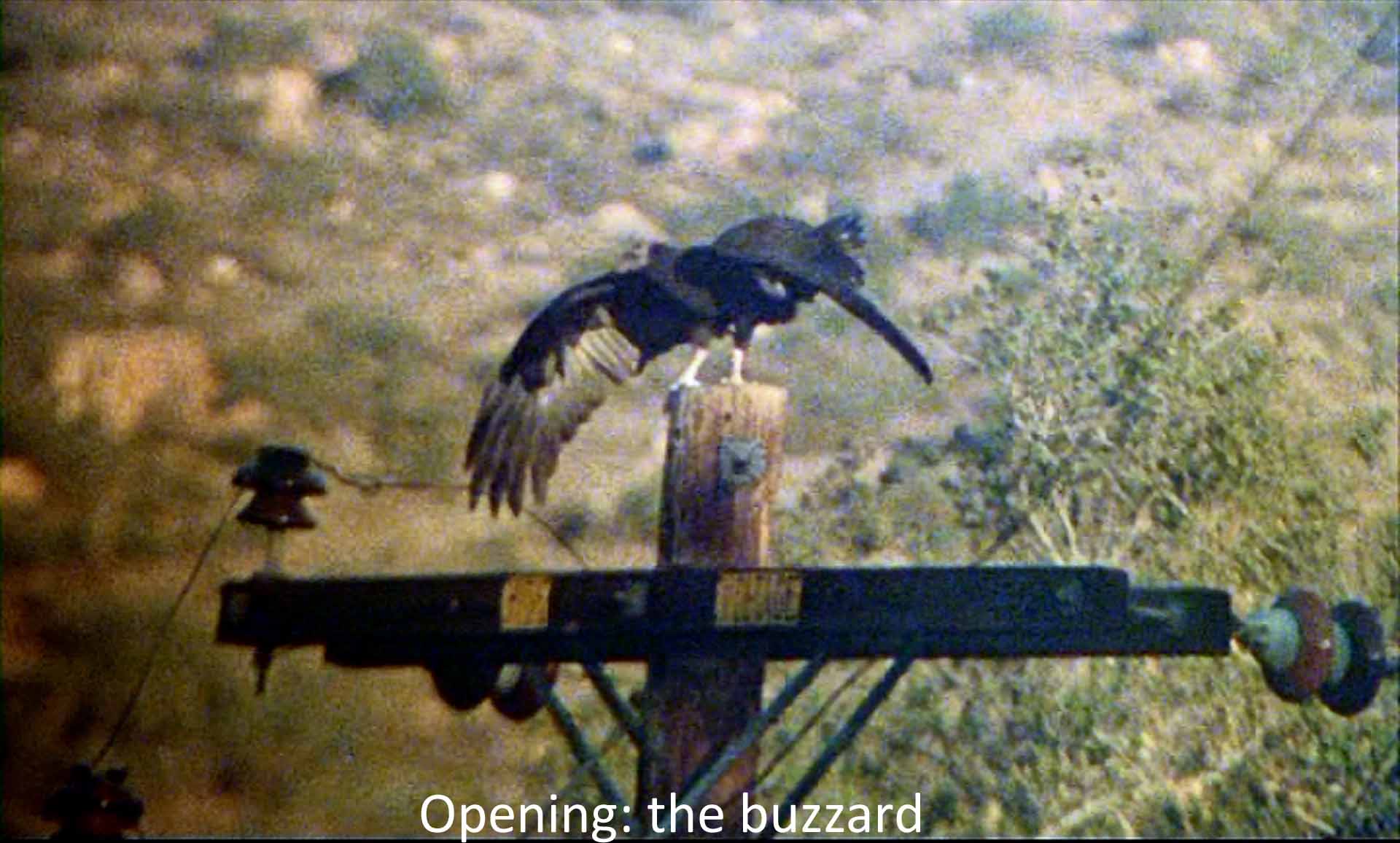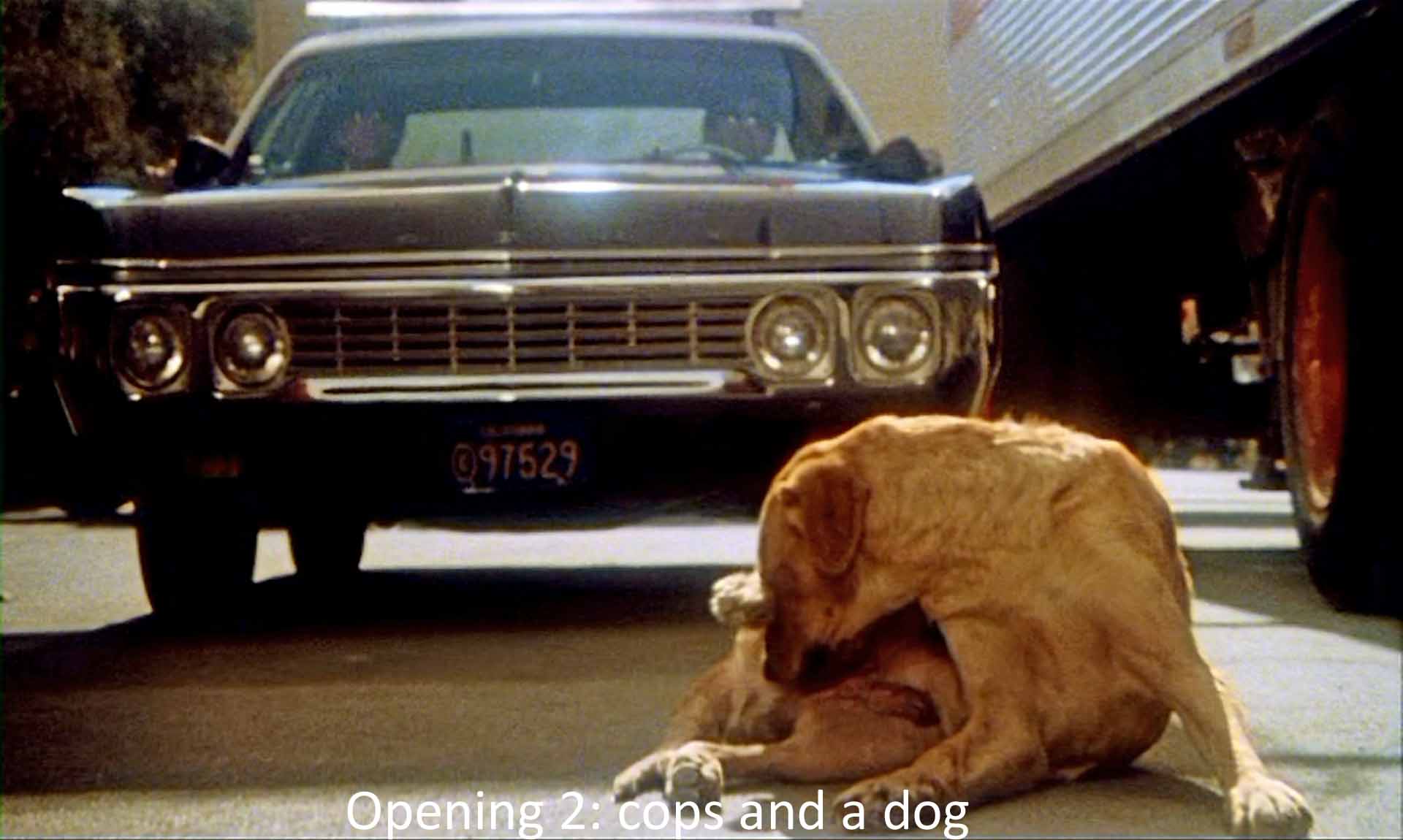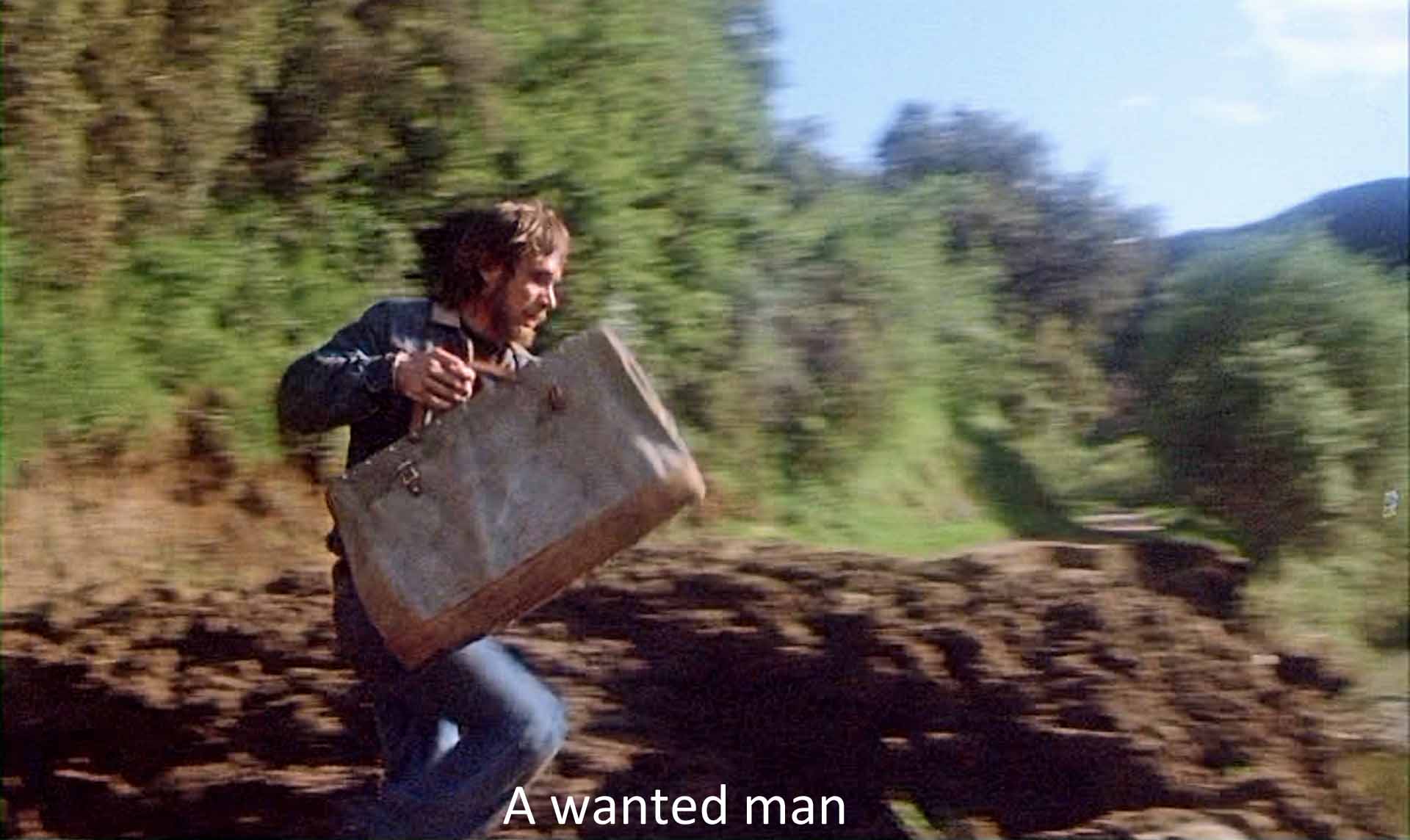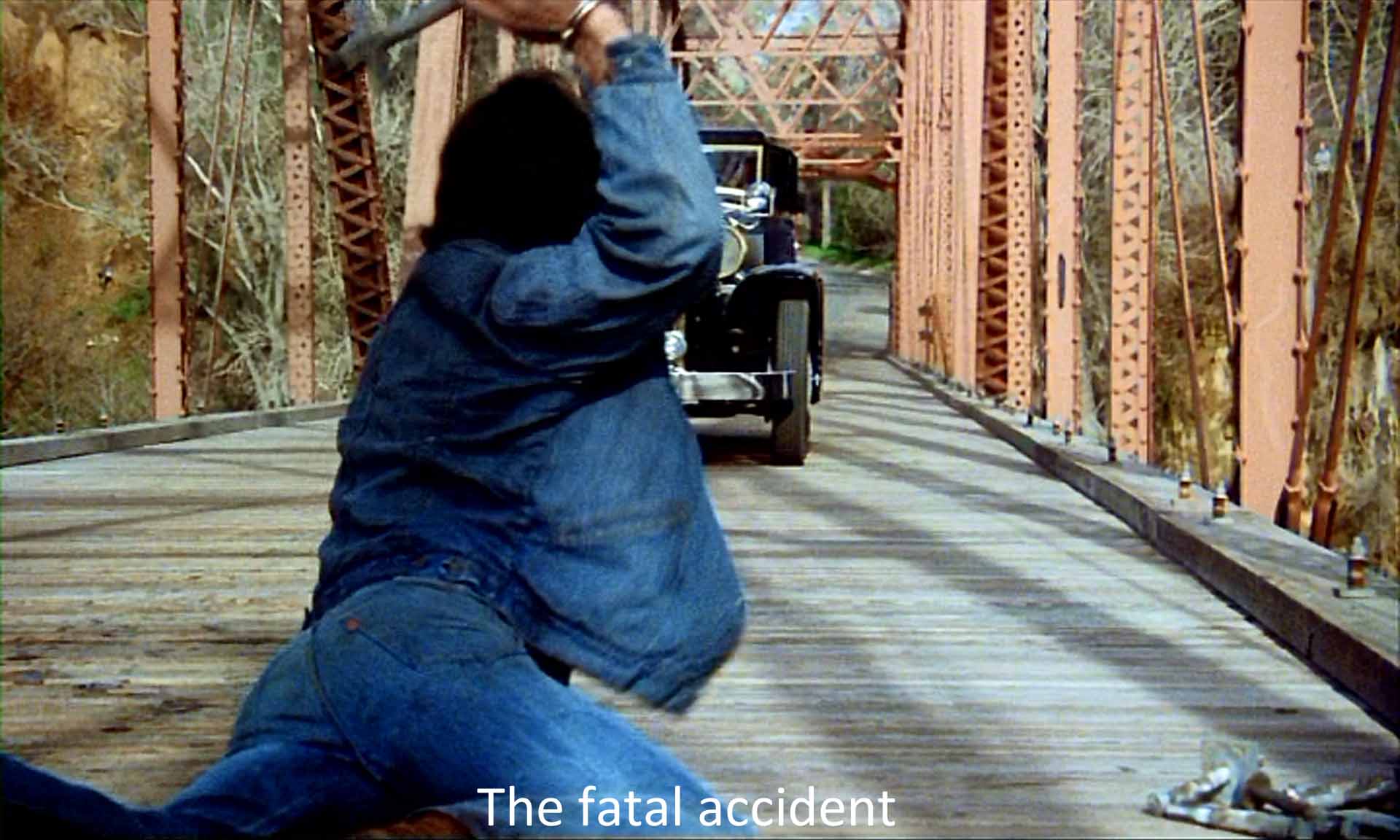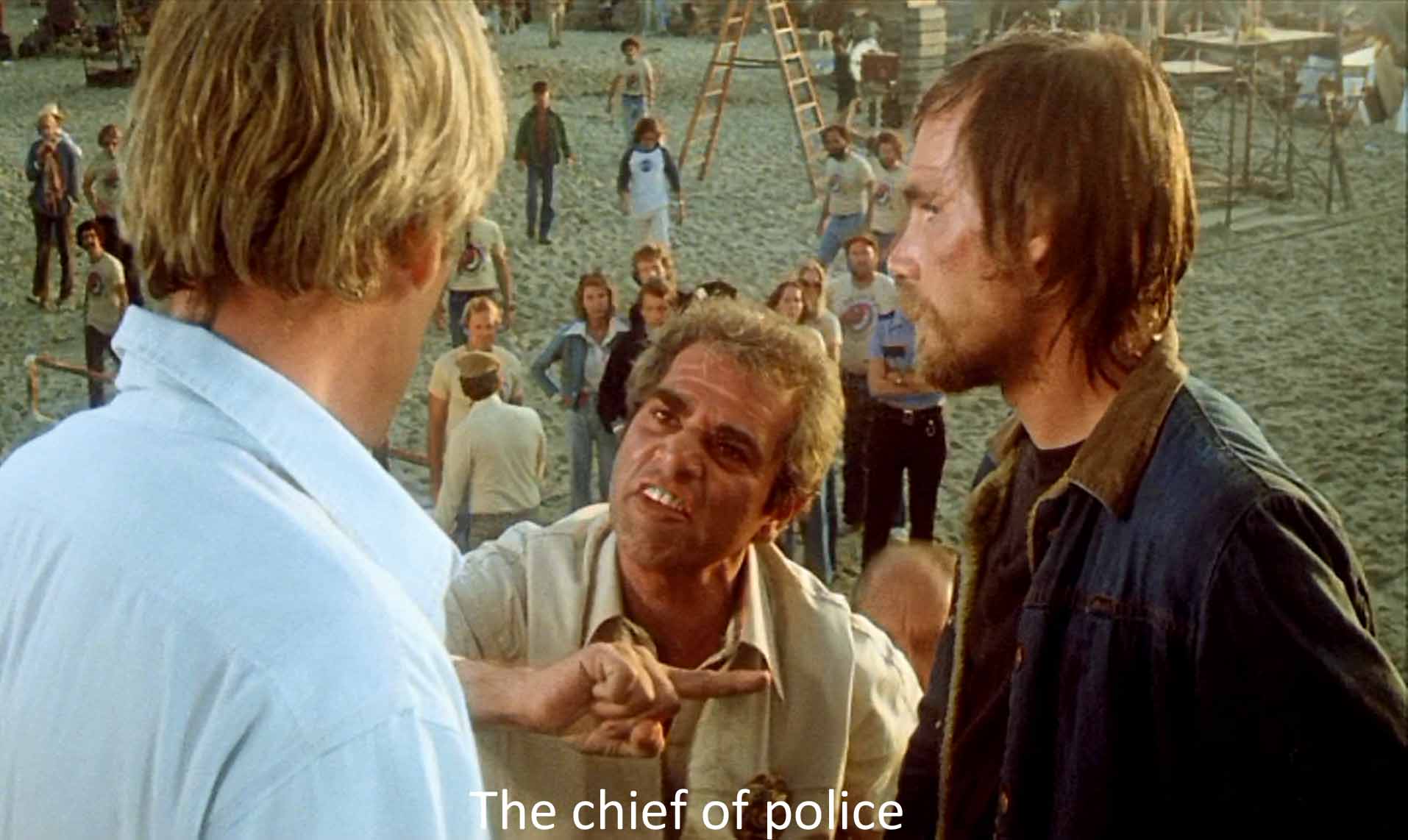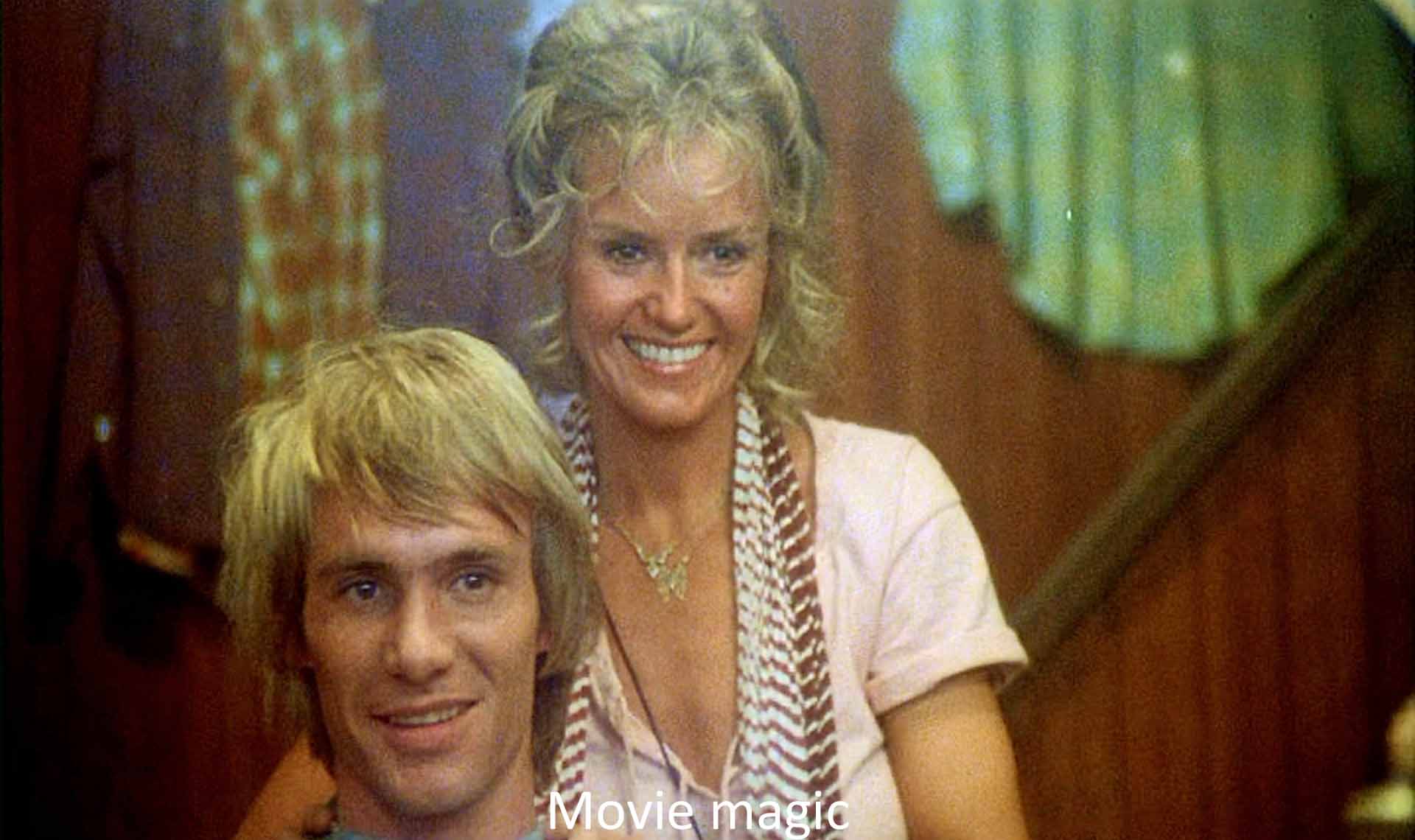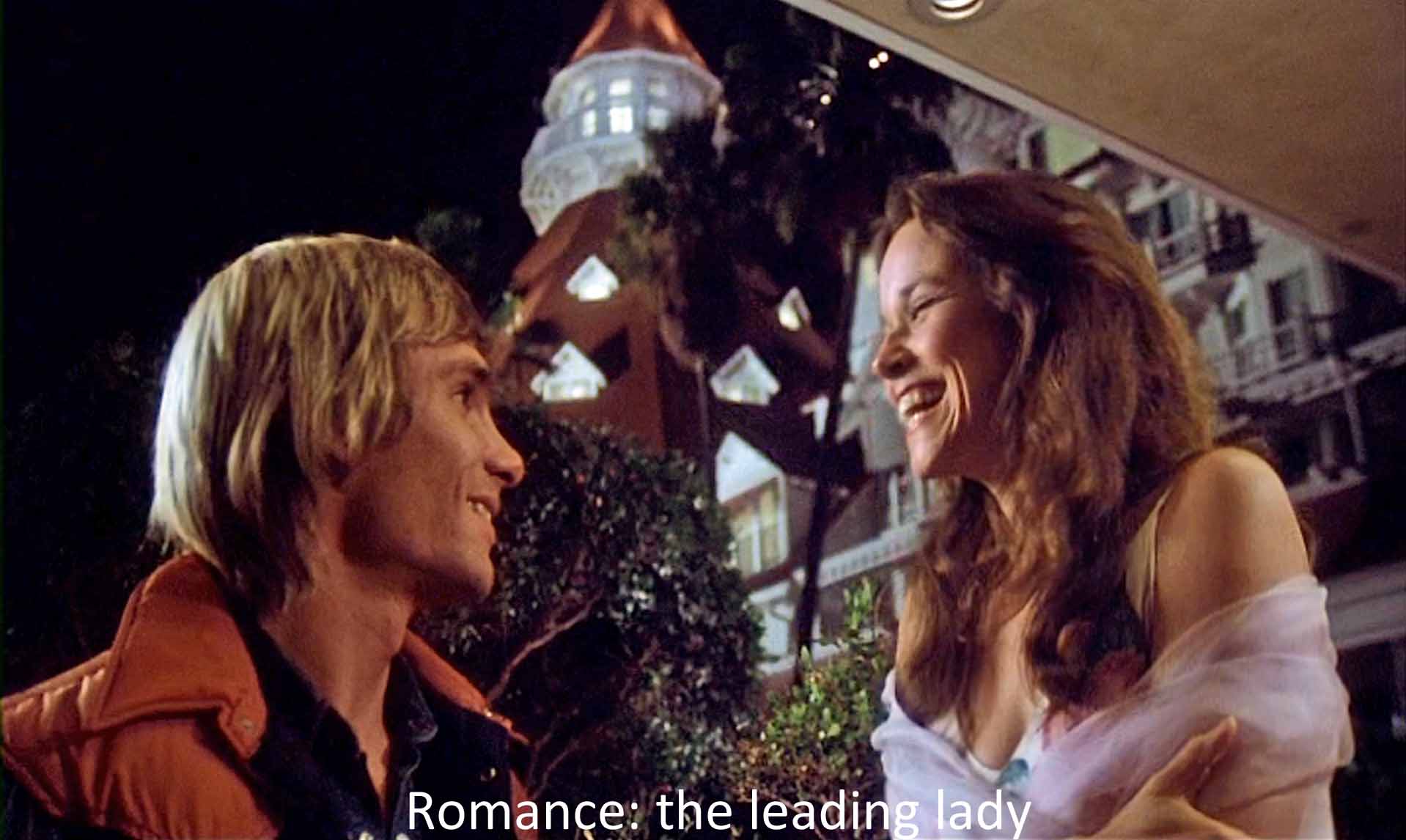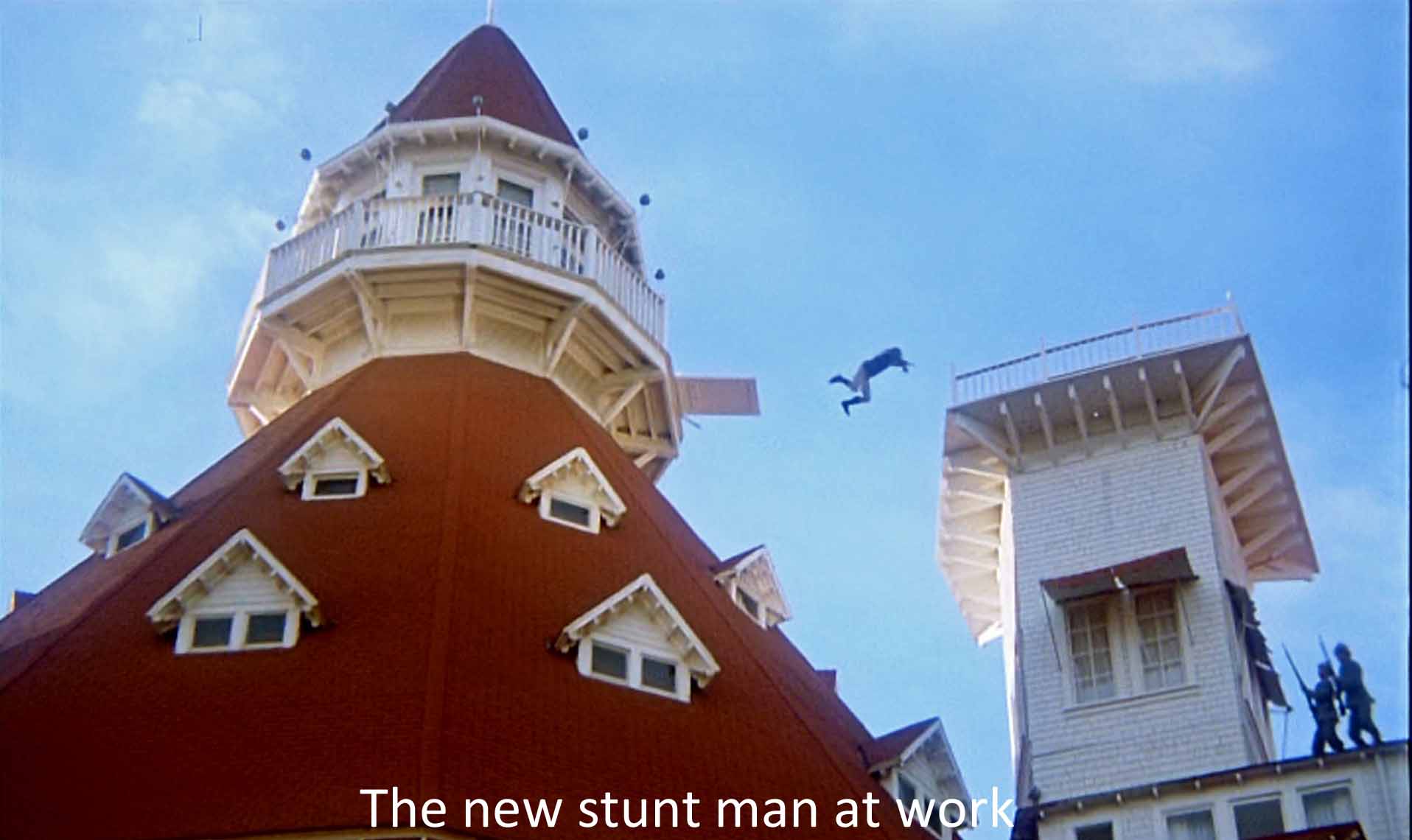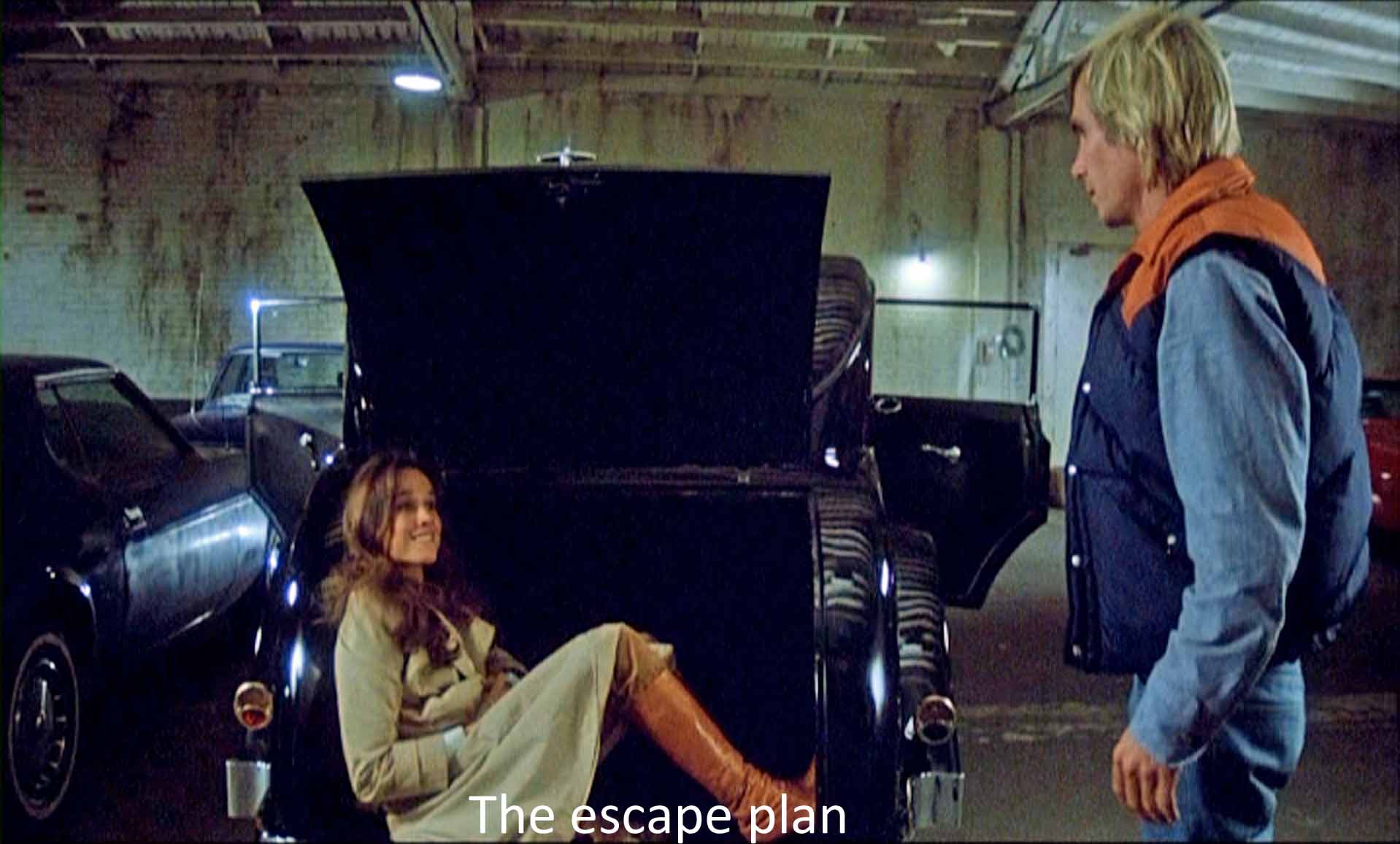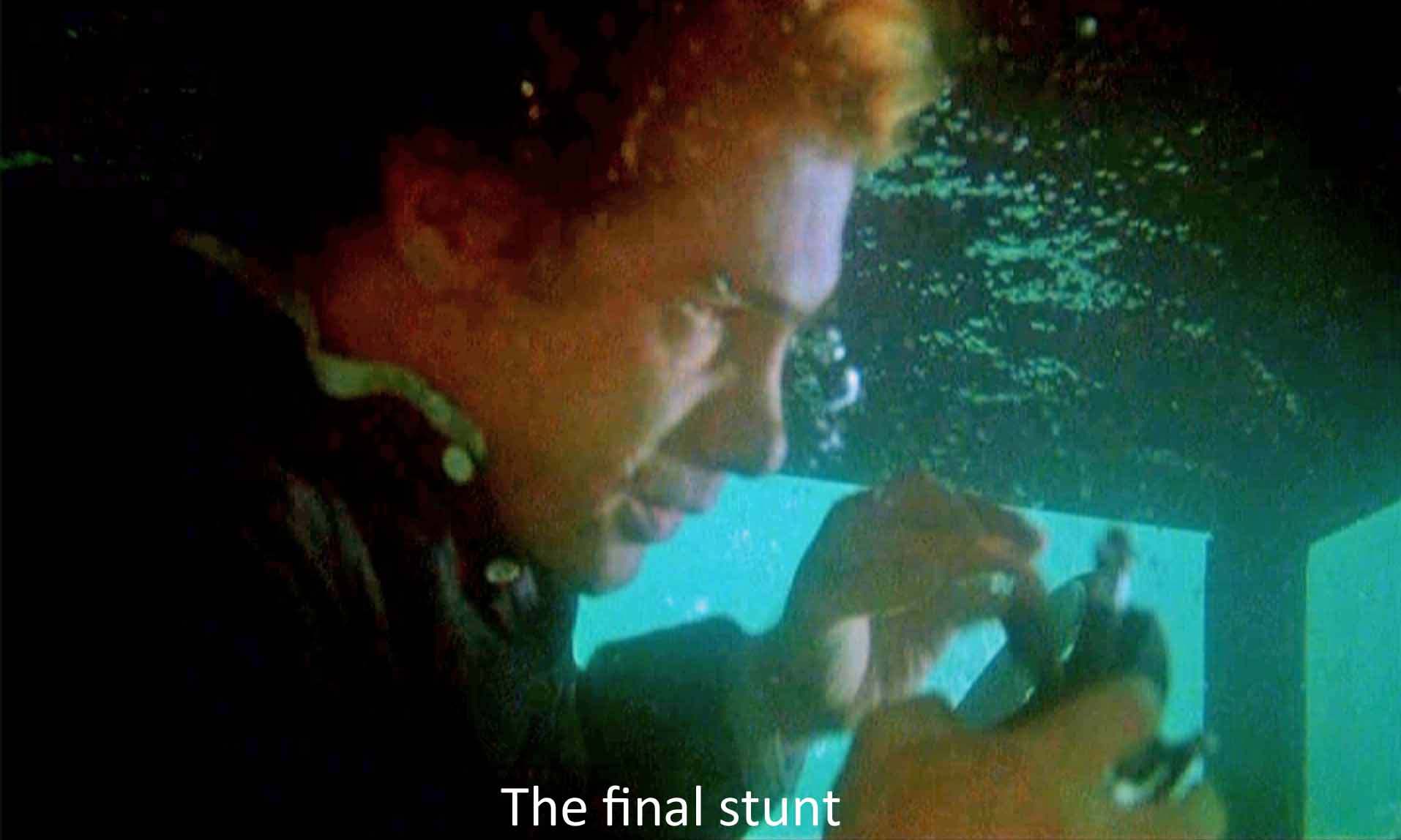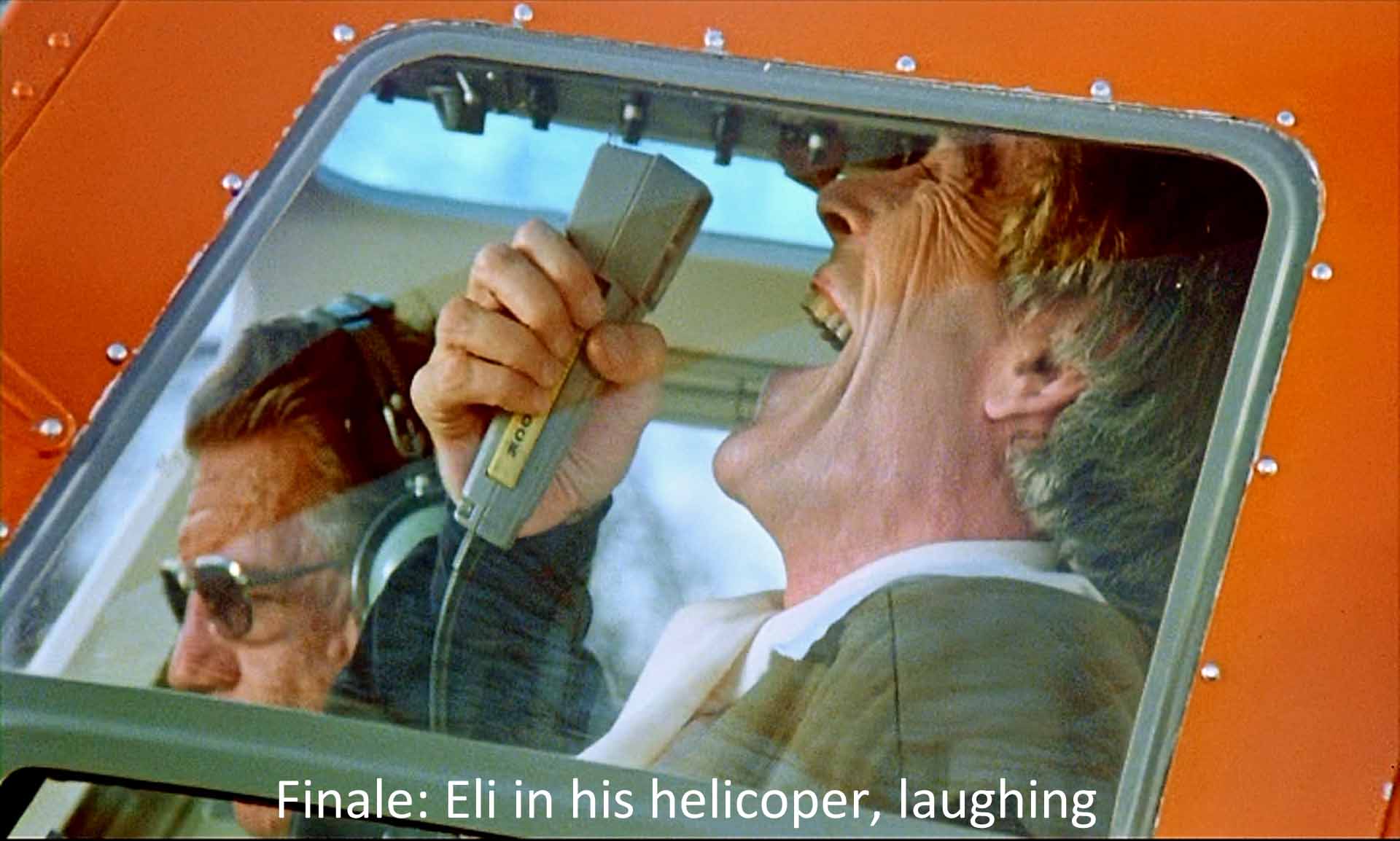Opening. Action! An agile fugitive (an angry Vietnam veteran whose eyes are Hell’s Angel deadly) escapes from the police who have surrounded him in a roadside diner. Cameron or Camera-on (Steve Railsback) knocks down a telephone lineman, uses his boltcutters to sever his handcuffs, and makes his way to a bridge. There he is apparently offered a ride in a huge Dusenberg (what is a mint-condition Dusenberg doing out in the middle of nowhere?), but the driver kicks him out the door and seemingly tries to run him down. When the fugitive throws a big bolt at him, the car careens off the bridge, and nothing and nobody comes up.
Our sinister escapee with the dead eyes and big eagle tattoo makes his way to a beach where a crew is shooting a World War I movie in front of crowds of beachgoers who applaud the shootings and cringe at the appallingly realistic gore. Our hero rescues an old lady from drowning, but she peels off her makeup and reveals Nina Franklin (Barbara Hershey), the beautiful leading lady and star of a sexy tv commercial our hero had admired in the diner.
Confused? Yes, so was I.
Eli Cross, the tyrannical director (Peter O’Toole), now appears, shaken by the disappearance (drowning?) of his stunt man in the Dusenberg. When the police chief, further enraged by this new intrusion on his peaceful town, comes to berate him, Eli blackmails the fugitive Cameron into becoming “Burt,” the drowned stunt man, now to be known as “Lucky.”
We see the omnipotent Eli deal with the time and money agonies of the producer, the rewrites of the writer, hassles from the police, and we see various scenes of his “movie within a movie”: the hero’s escape from dozens of German troops firing at him, leaping from rooftops and through a brothel, dancing a Charleston on the wing of a biplane, being run down by tanks, and so on. During all this, “Lucky” develops into a brave and capable stunt man, who falls in love with Nina and she with him, despite his disappointment that she has slept with Eli.
When the time comes to redo the Dusenberg’s crash off the bridge, Cameron fears that Eli is so eager to get film of a man drowning he has gotten like an indifferent general sacrificing an infantryman. Lucky plans simply to run away in the car instead of driving it off the bridge, and Nina (after he has explained the innocence of the “crime” for which the police are pursuing him) hides in the trunk to go with him. When Cameron starts racing away, however, the stunt boss blows out a tire, Lucky goes off the bridge and nearly drowns, watching Eli and Nina(!) out the back window as the car sinks. But he survives to embrace Nina (who tells him the omniscient Eli discovered her ten minutes after she hid) and to argue with Eli whether the stunt entitles him to $650 or $1000. The film’s last line is a throwaway, coming as the screen goes blank after the credits: Eli calls down from his helicopter an order against Cameron, “Rewrite the ending real [reel?]. Crush the little bastard in the first act.”
To me, one extraordinary thing about this film, and it seems to me one of the extraordinarily good films of the seventies-eighties, is the way it juggles a dizzying number of themes especially in a bewilderingly fast and multifaceted opening. The opening credits and the sequence that follows them involve, it seems to me, four different kinds of reality. There is this film as this film, with its credits and the drawing of a buzzard that dissolves into a second level of reality: a wholly symbolistic set of shots involving a buzzard and an old hound dog. They symbolize the third level, the “real” world in which the police are surrounding Cameron, but there is also a fourth: the helicopter in this sequence which will segue into the Dusenberg on the bridge and the movie within the movie. This film is “about” the interplay of film, symbolic shots, film “reality,” and illusory realities (like Nina’s being in the trunk of the Dusenberg). And they all are anti-war (as Eli tells us).
Why does the driver of the Dusenberg stop, as if to offer Cameron a ride, then kick him out the door? Why did he drive straight at Cameron? Did Cameron cause his death? Only much later can we understand that all this makes sense because the driver was doing a stunt for a movie and he thought Cameron was one of the crew in the wrong place at the wrong time, all part of the movie-movie.
Why did the real director (Richard Rush) take special shots of the buzzard perched on a telephone pole watching the police cordon? Why linger on the old snarling dog who will not get up from his sleeping spot to let the patrol car pull through? As for me, it was only when I had seen the whole film through, when I had a god’s eye view of it, that I could see that the snarling dog has to do with the theme of fighting and war (the dog snarls the way Cameron does). I could contrast that dog with the dog a minute or two later that jumps through Nina’s legs in the tv commercial. Make love, not war. The buzzard on high corresponds to Eli who continually rides around on a crane or flies in his helicopter, observing—knowing—everything. Make movies, not war.
The contrast between the dog and the buzzard recurs in the two telephone linemen Cameron confronts in his escape: one chooses to fight (like the dog); one climbs up the pole to observe (like the buzzard). Other tiny episodes in the opening seconds symbolically foreshadow later themes. A youth tries to control the pinball machine as Eli controls his film. The waitress’ dog barks at the man trying to feel her up, as Nina wards off Lucky. The police try—and fail—to take control of Cameron, and throughout, they fail to control their reality.
In other words, the discontinuity of the opening scenes shades off into continuity, life into art, reality into illusion, and this is true throughout the film. Much later, for example, Eli will tell Nina that her parents accidentally saw her nude scene (true). Then he uses her all-too-real shame and grief and anger to build a fictional scene in which she (as the Austrian woman in the film) reacts to her son’s death for the sake of Hitler. That is one of the major threads in the film (as I see it): transform reality into art. The other is the ethical theme: transform hate into love.
The film mentions World War I, World War II, Korea, and Vietnam—a full house of hostilities. As Eli muses, “People die, so they fight wars. And they fight windmills.” It is the latter he stands for, the impossible challenge of film making. It is fighting wars that Cameron stands for. As he says, “To get home for Thanksgiving, you’ve got to figure the guy coming at you is trying to kill you.” Cameron, in his rage at being betrayed while he was in the service, turns even ice cream and Donald Duck into weapons. This movie turns them back into laughter, and on a hilarious tumble among falling cans, into the paint which makes movie magic.
In combat and in sex, bodies engage. Thus the film cuts from one of Lucky’s most frightening stunts to his orgasm with Nina. By contrast, you just look at a movie, the way Eli surveys the world from his helicopter or the way a man in the opening sequence just paints a seascape despite all the blood and gore the movie people are spreading over it.
The movie transforms reality into art. The “real” becomes a “reel,” and “shooting” becomes shooting film. Lucky becomes Burt the stunt man who in turn is supposed to become Raymond the star. Or vice versa. Constantly this film hovers between playacting, pretense, and the real, especially in the scenes between Nina and Lucky. Their playacting transfigures the ordinary emotions, to the point where I can scarcely tell what they really feel. As Eli says, pointing to the door of the make-up room (paint again): “That door is a looking-glass. And inside it is—wonderland.” Instantly Cameron is transformed into Lucky, a blond. And later he will see Nina through that transforming glass like a soft-focus lens.
We see miracles constantly in the film. “King Kong,” Eli keeps reminding us, “was three foot six.” Dead soldiers rise again. An old woman turns into a young beauty (from a dunking in the ocean—like Venus). Death and rebirth. (And then there is the real death, the original Burt’s death, with no rebirth).
At the same time, in a perfectly naturalistic way, Eli is “the leader,” commanding the loyalty of his troupe. Lucky is perfectly right to compare him to a general. He sits at the head of the table like a king among his courtiers, commanding their answers, receiving ambassadors (from the police), and dispensing his rulings. He can dismiss Nina for talking during screenings the way a teacher would send a schoolgirl out of class. For the stunt men, he has, literally, the power of life and death. He takes over Lucky’s life even more than the others, giving him a new identity, a refuge, a career, a lover. “I’m not real,” complains Lucky. “ I’m some jerk American flyer from World War I who has to . . . die because the goddamn script says so!” And he responds by respecting Eli, wanting to please him, but wanting also to escape him. The young man has to fight him, steal a woman from him, betray him. (Even to mention Oedipus in this context belabors the obvious.) The stunt trainer calls Lucky’s response, with perfect accuracy, “a crush.” “If we woke up Eli,” says Lucky to Nina when he has confessed the crime for which the police want him, “If we woke up Eli and told him about the ice cream, do you think he’d forgive me?”
You could read Eli then as the prototype of the leader, but he goes farther. “The sonuvabitch knows whatever I’m thinking,” complains Lucky, and indeed Eli knows everything, every scheme, every plot, every peccadillo. And he seems able to do everything. “If God could do the tricks we can do,” says Eli, “he’d be a happy man.” That is what Eli does, transform God into man and man into God. He promises that he will first kill his enemies and then eat them. He demands that Sam, his writer, give him something both “outrageous” and “real,” like the world itself.
In short, as the director (in the fullest sense of the word), Eli becomes godlike. “I therefore order no camera to jam, no cloud to pass before the sun,” he proclaims from atop the bridge before shooting the final scene. Throughout the film Eli, whose name means “high”, has been riding his helicopter or swinging from a crane looking at all and knowing it all from above. He is the deus ex machina, the god who descends from the heavens on stage machinery and makes all well.
He is godlike, but it seems to me he is one particular god. A god of laughter, for as in the two big scenes of reconciliation, when Nina accepts Lucky crime and all and when Lucky is reborn from his drowning at the end, all dissolves in laughter. He is, moreover, epicene. Peter O’Toole plays him with more than a hint of the bisexual or the homosexual, as he flirts with Lucky. The script allows for jokes about Eli Cross’s proclivities, as in the animated finger that proclaims “Eat at Eli’s joint.” And when Eli flies off in his helicopter at the end, it sends out pink and blue smoke, as if to say he is both boy and girl. Eli, it seems to me, despite the Cross in his name, stands for one particular god, the god who controls and masters such petty divisions as those between the sexes, life and death, rational and irrational, the god (appropriately enough) of theatre. Eli is the Dionysus of the movies.
Dionysus is the god of our control (and our lack of control) of the irrational. In theater (or movies) he lets us give in to it—and recover. Just as plays combine a deterministic script with the actor’s inspiration and impulse of the moment, so Eli controls totally everything that goes on in and around his movie, but he also gives way to the paradoxical and the magical: the death and rebirth of “Burt,” the menace of Lucky, Nina falling in love, his own flummoxing the police. Above all, he gets his film crew to do the outrageous thing on screen that will be the mad success in the film (the heroine’s laying a bawdy Victorian bronze on her lover’s grave, Lucky dancing a Charleston on an airplane wing). His film will make that point: make love, make movies, but don’t make war. By contrast, the police, who make war, not love, fail utterly in their efforts at control. Eli who gives way to the irrational, can live with it.
Art requires of us that we trust the artist, and it requires of him that he trust to—what? The gods, I suppose. Or us. So here, the director of this extraordinary film, Richard Rush, takes his chances with the incredibly obscure beginning, the dizzying number of themes, and even the throwaway line at the end that tells us Eli is both a creating and destroying, but above all, a laughing god.
